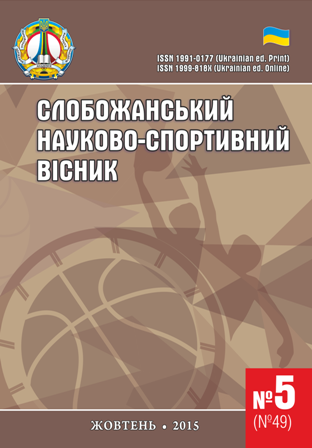Особливості харчування спортсменів-ектоморфів, які займаються бодібілдингом, у перехідному періоді підготовки
DOI:
https://doi.org/10.15391/snsv.2015-5.005Ключові слова:
особливості раціону, спортсмени-ектоморфи, тренувальний процес, перехідний період, оптимальна раціон, мікроциклАнотація
Мета: розробка та обґрунтування раціону харчування спортсменів-ектоморфів, які займаються бодібілдингом, у перехідному періоді підготовки з урахуванням відновлення м’язової маси тіла та функціонального стану спортсмена. Матеріал і методи: у дослідженні брали участь 18 спортсменів-ектоморфів, які займаються бодібілдингом, що включені до складу збірної команди Харківської області з бодібілдингу. Використовувалися методи: теоретичний метод та узагальнення літератури, педагогічне спостереження, педагогічний експеримент, метод математичної статистики. Результати: наведено порівняльну характеристику раціону харчування, яке було розроблено для спортсменів-ектоморфів, що займаються бодібілдингом, задля збільшення м’язової маси тіла. Спортсменів було розділено на дві експериментальні групи: перша ЕГ використовувала збалансоване харчування, що становить білків 2 грама на 1 кілограм ваги тіла та вуглеводів 4–5 г·кг–1, у другій ЕГ становило білків 3 грама на 1 кілограм ваги тіла та вуглеводів 6 грамів на 1 кг. Раціон другої ЕГ складається з 6-разового прийому їжі та становить близько 2800–3500 калорій у день. Висновки: на основі проведеного дослідження автором пропонується оптимальний раціон харчування другої експериментальної групи для спортсменів-ектоморфів, які займаються бодібілдингом.
Посилання
Borisova O. O. Pitaniye sportsmenov: zarubezhnyy opyt i prakticheskiye rekomendatsii [Sports Nutrition: international experience and best practices], Moscow, 2007, 132 p. (rus)
Golberg N. D., Dondukovskaya R. R. Pitaniye yunykh sportsmenov [Meals young athletes], Moscow, 2007, 240 p. (rus)
Dzhim V. Yu. Slobozans’kij nauk.-sport. visn. [Slobozhanskyi science and sport bulletin], Kharkіv, 2013, vol. 4 (37), p. 15–19. (ukr)
Dzhim V. Yu. Slobozans’kij nauk.-sport. visn. [Slobozhanskyi science and sport bulletin], Kharkіv, 2014, vol.6 (44), p. 34–40. (ukr)
Dzhim V. Yu. Naukoviy chasopis natsіonalnogo pedagogіchnogo unіversitetu іmenі M. P. Dragomanova [Science magazine National Pedagogical University M.P.Dragomanov], Kiіv, 2014, vol. 12 (53) 14, p. 36–40. (rus)
Druz V. A., Dorofeyeva T. I., Dzhim V. Yu., Pugach Ya. I. Vliyaniye emotsionalnogo sostoyaniya na vypolneniye dvigatelnoy deyatelnosti v ekstremalnykh usloviyakh yeye protekaniya [Influence of emotional state to perform motor activities in extreme conditions of its occurrence], Kharkov, 2014, 305 p. (rus)
Druz V. A., Buren N. V., Pyatisotskaya S. S., Dzhim V. Yu., Zhernovnikova Ya. V., Zadorozhnaya E. A., Pugach Ya. I. Obzornyy analiz po probleme «Teoretiko-metodologicheskiye osnovy postroyeniya sistemy massovogo kontrolya i otsenki urovnya fizicheskogo razvitiya i sostoyaniya fizicheskoy podgotovlennosti razlichnykh grupp naseleniya» [Survey analysis on the problem of "Theoretical and methodological bases of construction of system of mass control and assess the level of physical development and physical readiness of various groups of the population"], Kharkov, 2014, 127 p. (rus)
Sheyko B. I. Pauerlifting : nastolnaya kniga trenera [Powerlifting: Handbook trainer], Moskva, 2003, 532 p. (rus)
Oleshko V. G. Silovyye vidy sporta [Power Sports], Kyiv, 1999, 287 p. (rus)
Platonov V. N. Sistema podgotovki sportsmenov v olimpiyskom sporte. Obshchaya teorіya i yeye prakticheskiye prilozheniya [The system of training athletes in Olympic sports. Total teorіya and its practical application], Kiyev, 2004, 808 p. (rus)
Vinogradov G. P., Gazimov R. R., Stepanov V. S., Shabanov A. I. Novyy metod trenirovki v bodibildinge [A new method of training in bodybuilding], Saint Petersburg, 1997, 79 p. (rus)
Dzho Uayder. Sistema stroitelstva tela [System construction body], Moskva, 1991, 112 p. (rus)
Veyder B., Veyder D. Klassicheskiy bodibilding: sovremennyy podkhod «Sistema Veyderov» [Classic bodybuilding: a modern approach "system Vader"], Moscow, 2003, 432 p. (rus)
Konnors E., Grimkovski P., Kimber T., Mak-Kormik M. Bodibilding : balans krasoty i zdorovya [Bodybuilding: a balance of beauty and health], Moscow, 2000, 174 p. (rus)
Kleiner S. M. Nutrional status of nationally ranked elite bodybuilders / S. M. Kleiner, T. L. Bazzarre, B. E. Ainsworth // International Journal of Sport Nutrition. – 1994. – № 4. – P. 54–69.
Cornelius A. E. Applications of multilevel modeling in sport injury rehabilitation research / A. E. Cornelius, B. B. W.rewer, J. L. Van Raalte // International Journal of Sport and Exercise Psychology. – 2007. – vol. 5(4). – pp. 387–405. – doi:10.1080/1612197X.2007.9671843.
Visek A. J. Athletic identity and aggressiveness: A cross-cultural analysis of the athletic identity maintenance model / A. J. Visek, J. C. Watson, J. R. Hurst, J. P. Maxwell, B. S. Harris // International Journal of Sport and Exercise Psychology. – 2010. – vol. 8(2). – pp. 99–116. – doi:10.1080/1612197X.2010.9671936.
##submission.downloads##
Опубліковано
Як цитувати
Номер
Розділ
Ліцензія
Авторське право (c) 2015 (Viktor Dzhym) Джим Віктор Юрійович

Ця робота ліцензується відповідно до Creative Commons Attribution 4.0 International License.
Наше видання використовує положення про авторські права CREATIVE COMMONS для журналів відкритого доступу.
Автори, які публікуються у цьому журналі, погоджуються з наступними умовами:
1. Автори залишають за собою право на авторство своєї роботи та передають журналу право першої публікації цієї роботи на умовах ліцензії Creative Commons Attribution License, котра дозволяє іншим особам вільно розповсюджувати опубліковану роботу з обов'язковим посиланням на авторів оригінальної роботи та першу публікацію роботи у цьому журналі.
2. Автори мають право укладати самостійні додаткові угоди щодо неексклюзивного розповсюдження роботи у тому вигляді, в якому вона була опублікована цим журналом (наприклад, розміщувати роботу в електронному сховищі установи або публікувати у складі монографії), за умови збереження посилання на першу публікацію роботи у цьому журналі.

 До уваги авторів!
До уваги авторів!


